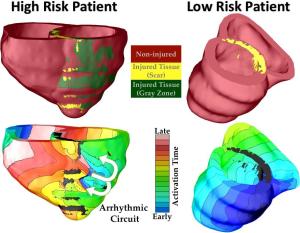
An interdisciplinary team of researchers at Johns Hopkins University discovered that 3D models of patients’ hearts could help doctors assess a person’s risk of developing life-threatening arrhythmias. Sudden cardiac death from arrhythmias is a leading cause of mortality, and for high-risk patients, insertion of implantable defibrillators can help reduce mortality. Researchers created personalized computer models based on MRI scans for 41 patients who had previously experienced a heart attack. They then retrospectively tested the subjects’ results using clinical data from the patients. The research team found that their approach significantly outperformed existing clinical metrics for predicting future life-threatening changes in heart rhythm.
Authors:
Hermenegild J. Arevalo, Fijoy Vadakkumpadan, Eliseo Guallar, Alexander Jebb, Peter Malamas, Katherine C. Wu, Natalia A. Trayanova
Corresponding author:
Natalia A. Trayanova, Institute for Computational Medicine and Department of Biomedical Engineering, Johns Hopkins University
Original paper published on May 10, 2016 in Nature Communications.

